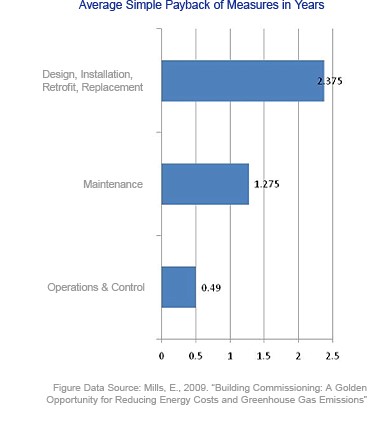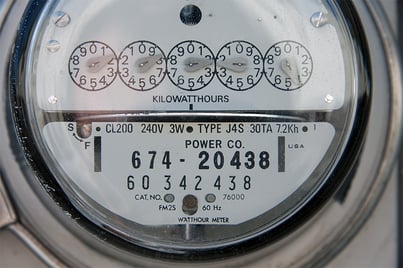Retro-commissioning (RCx) is a process that ensures existing buildings and systems operate optimally and efficiently. This involves activities like scheduling, sequencing, controls programming, and optimizing set points of various systems in the buildings. The focus of RCx is improving the efficiency of existing systems instead of replacing them. Retro-commissioning projects not only tune-up your building’s energy efficiency but also extends the service life of most of the equipment in the building.
Retro-commissioning often improves a building’s faults that arise due to poor design or problems that occurred during initial construction. They also address issues that arise during the life of the building due to the usual wear and tear. Hence, a retro-commissioning project improves the overall operations and maintenance of a building as well as enhances the building performance.
However, like with anything else, RCx comes with a cost and it can be huge or less depending on the number of systems and the project work you prioritize.
Most retro-commissioning projects have favorable return on investments. Despite that, facility managers and other property personnel are always challenged with funding sources since budgets are usually tight.
According to a study, the average payback period can be as quick as 6 months or as long as two and half years.

The good news is that with the emphasis on newer technologies for commercial buildings like green buildings, there are options and incentive programs to help pay for the retro-commissioning projects. According to research by California Energy Commission, partial or full utility rebates were received in 84% of the cases in existing buildings projects.
This article will focus on helping you understand these incentives to aid in planning and executing these RCx projects.
Types of incentives:
- Prescriptive rebates:
In order to help building owners, facility managers and all other operators of a building perform retro-commissioning, there are rebates that are offered by many organizations. Some of these rebates help fund various RCx activities. They may be service incentives or cash incentives. The utility company pays the engineering firm or any other service provider directly for their technical expertise for performing the retro-commissioning assessment. The incentives range anywhere from 100 percent of services in cities like Chicago to 50 percent of services in other cities like New York. Cash incentives include providing a check to the commercial building owner based on the RCx project size and impact.
In order to obtain this utility incentive, buildings have to work with the sponsor utility company by hiring them for the RCx project or a third-party expert who is an approved provider of the utility company that provides the rebates.
There are many examples of successful retro-commissioning projects that have availed such rebates. One such example is the Hyatt Center is Chicago that was initially constructed in 2005. Since it is a new building it has a robust fully digital control system. These systems had to be adjusted and recalibrated based on outside temperature feedback and the load had to be adjusted accordingly. The result was an annual electric savings of 1,613,526 kWh. The total RCx cost was about $26,000, which included a controls contractor and in-house labor costs and resulted in a simple project payback of just four months. Retro-commissioning services were paid for in full by the ComEd program.
- State offered incentives:
Many states offer existing buildings incentives for retro-commissioning. Participants should meet the eligibility criteria in the states in order to qualify. Before they can be approved, the energy measurement analysis has to be conducted, reviewed and approved. Projects are also subject to cost-effectiveness review. While typically only buildings over 20,000 square feet are cost-effective for RCx, any eligible building may be qualified for RCx if the Existing Buildings team determines that the measures can be cost-effective.
For example, in the state of Illinois, Smart Energy Design Assistance Center (SEDAC) has been established to administer and execute the Public Sector Building Retro-Commissioning (RCx) Program throughout Illinois. SEDAC's Retro-Commissioning services are free for local, state, and federal governments; public school districts; community colleges; and universities that receive electricity distribution service from Commonwealth Edison (ComEd) or Ameren affiliated utilities (AmerenCILCO, AmerenIP, and AmerenCIPS) as a result of Illinois DCEO funding. Clients are required to implement at least $10,000 on building improvements based on recommendations, and must implement the measures within 10 months or by the program year deadline.
Most other states offer similar incentives and you can easily find more about them by looking at your state’s energy incentive programs.
- Demand-response and load management programs:
In order to understand the demand-response programs, we will look at what exactly it entails. Automated demand response or ADR as it is commonly called is a Demand Response program that provides incentives for customers investing in RCx projects or any energy saving measures. This program offers incentives if you implement automated controls to reduce energy consumption. The automated controls also help to improve indoor air quality by reducing the peak emissions and automated control of them.
As per Wikipedia Load management, “also known as demand side management (DSM), is the process of balancing the supply of electricity on the network with the electrical load by adjusting or controlling the load rather than the power station output.”
This can be achieved by automating the usage in real time. Load management helps in saving electricity during peak usage times and helps in reducing the costs.
If any of your retro-commissioning efforts are targeted towards either including demand-response initiatives or load management projects, then you would be eligible for qualifying incentives.
Take the example of the retro-commissioning project for peak electric demand reduction in New York City. The financial incentives provided were about $3,240,000 to fund the retro-commissioning activities. Incentives for implementation and other follow-on services were allocated to the retro-commissioning provider payable at the rate of $350/kW for achieving a minimum system coincident summer peak electric demand reduction of 125kW per facility.
Conclusion:
In conclusion, retro-commissioning helps with running the systems smoothly in an existing building but you might be challenged with the costs associated with it. There are many local, state, federal and commercial incentives that can help with the financial resources required for a RCx project. Some of them offer prescriptive rebates; most states offer many incentives as long as the RCx efforts showcase energy savings or green building initiatives. The last powerful RCx incentive is the load management and demand response incentives. They focus on implementing automatic controls to manage electric demand as well as to offset peak load costs. With the help of any of these options, you would be able to achieve your next retro-commissioning project goals sooner than later.




